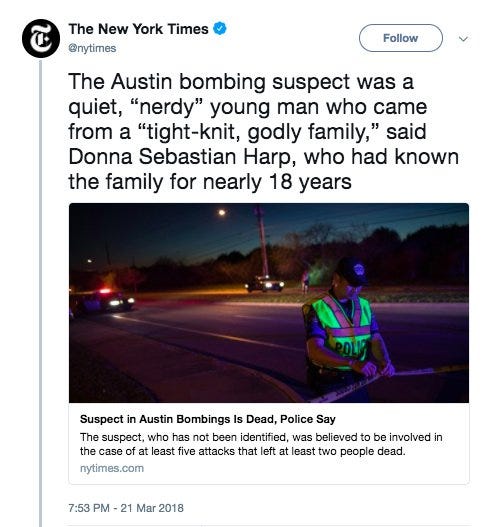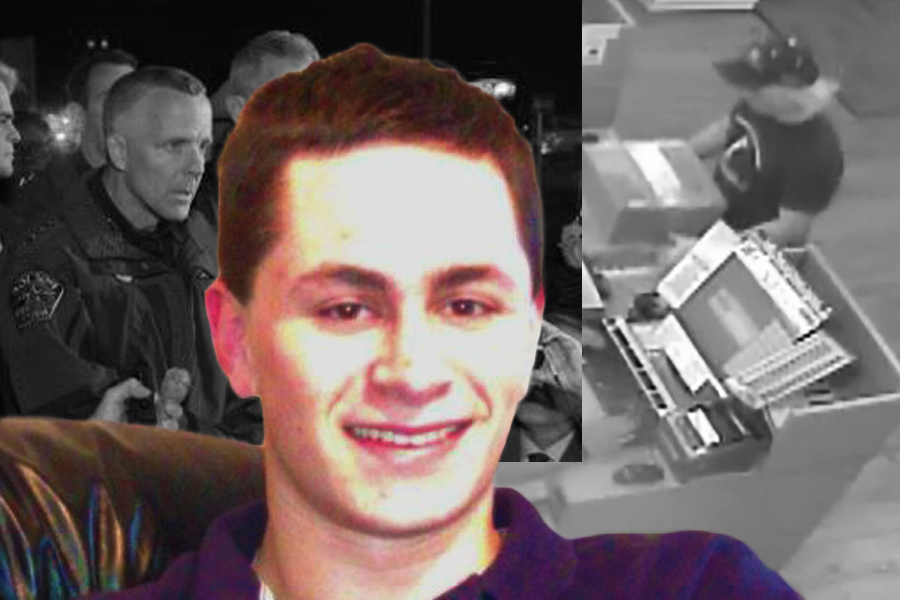There’s something odd about the reports describing Mark Conditt, the now-deceased suspect in a serial bombing spree that killed two and injured five people in Austin, Texas. I can’t quite put my finger on it, but maybe you’ll see a pattern here:



Go ahead and heave a deep sigh. You know this is nothing new. Even supposedly progressive media outlets divide mass murderers into brown terrorists and “mentally ill” white folks. They vilify the unarmed black victimsof police shootings while rationalizing officers’ actions. But it’s especially irresponsible to sweep a killer’s toxic worldview under the rug when both hate crimes and gun massacre casualties are on the rise. It’s a cowardly abdication of civic duty for a police chief to say Conditt was spurred by “challenges in his personal life” and for the Washington Post to claim there is “no evidence” of “radicalization” in blog posts where he argued that gay people are aberrations who do not have human rights. It’s flat-out wrong how the Parkland shooter’s fondness for swastikas, Trump, and horrible social media threats toward Jews and people of color were largely overlooked by the press, and that headlines described a school shooter in Maryland as “lovesick” over a run-of-the-mill romantic rejection.
It’s not hard to see the complexity in people, which is why the aftermath of these fatal paroxysms always includes quotes from friends and family that paint the perpetrator as smart, gentle, shy, and kind. These shocked reactions are completely understandable, and they’re part of the narrative — but far from the entire story. Just one day after Conditt blew himself up in a car, leaving behind a 25-minute video confession as authorities closed in, Austin’s interim police Chief Brian Manley said, “[W]e’re never going to be able to put a [rationale] behind these acts.” Why the hell not? Did anyone try? It’s a bizarre comment seeing as we’re still shoveling out from under a lot of misinformation spread in past weeks and poring over Conditt’s list of future targets for connections. The rush to declare him effectively normal and his actions random (whereas, for example, anti-fascist protesters are “violent,” “intolerant,” and “radical”) is altogether disturbing.
hey how about that the austin bomber was a deeply mediocre white man with the most basic-ass bone-stock conservative psuedopolitics with the reek of having been culled entirely from online comments who could have predicted
— Graviscera (@gravislizard) March 21, 2018
There’s another wrinkle for the Austin case, however: If Conditt’s stated politics weren’t as extreme as, say, Nikolas Cruz’s, does that make them irrelevant? We have a hard enough time recognizing widespread right-wing terrorism in the U.S. for what it is; we’re kidding ourselves if we think we can dismiss Conditt’s homophobic, anti-abortion, pro-capital punishment writings as symptoms apart from his orchestration of a one-man assault on a major city that happens to be the big blue oasis in a blood-red state. Maybe, because so many in the current governing and pundit class are pushing those same ideas, it feels impolite to point this out. Well, fuck that — if he’d shared a single Bernie Sanders meme on Facebook, we wouldn’t hear the end of it. This guy openly worried that putting sex offenders on a registry might prevent them from “making friends.” We have zero obligation to overlook any such scrap of his personal philosophy.
Also, there is roughly a ~0% chance that there isn't a trail of this guy on dark corners of Reddit/4chan/alt-right Discord servers/whatever. pic.twitter.com/e18mOWcErS
— Joshua Benton (@jbenton) March 22, 2018
What’s really frightening in this last wave of sensational killings is that the coverage accepts the murderousness of these young men as both unpredictable and inevitable: Boys will be boys, and feeding off the internet’s conservative bile in 2018 is no red flag. Surely none of them drew inspiration from the race-baiting, feminist-bashing, everyone’s-coming-to-get-us mindset that dominates reactionary forums and YouTube channels. Fox News may run white supremacist shows, but white supremacy is mainstream, so whattaya gonna do? The messaging on Mark Conditt, James Fields and other charged or suspected terrorists with murky right-leaning ideology, has a distinct undercurrent of “better get used to it” that suggests a disinterest in the lives they led before the AR-15s and tripwire explosives. That won’t help us pin down root causes, and it certainly won’t discourage the next “normal” kid to follow in their bloody footsteps.
But yeah, go ahead: Let them be relatable. Tell us how bad they had it in school, or while adjusting to adulthood. Give us a way to excuse their unholy actions. Above all, destroy the correlation between the rhetoric of “American Carnage” and those who actually carry it out. Put another bandage on another wound without bothering to clean it first.

